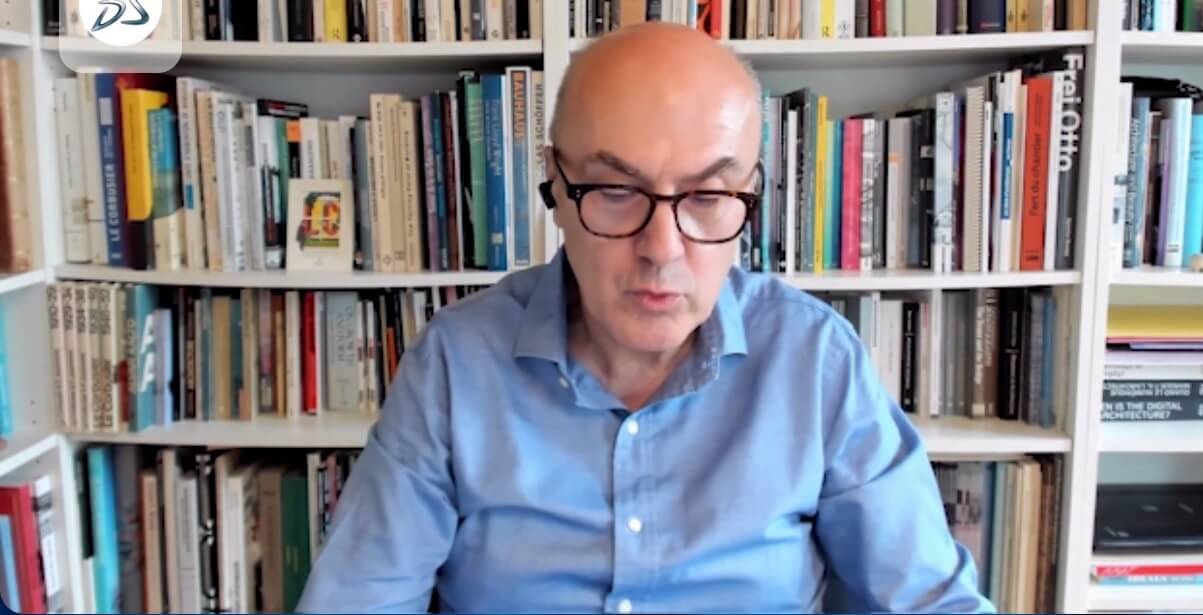Says Prof. Antoine Picon, professor of the history of architecture and technology at Harvard University, and director of doctoral programs. Prof. Picon is a member of the French Academy of Architecture and the French Academy of Technology. Picon said these things at the virtual conference "Journey in the Age of Experience" organized by Dassault Systèmes

"Big data can be harnessed to improve the functioning of cities, especially in light of the Corona epidemic." Says Prof. Antoine Picon, professor of the history of architecture and technology at Harvard University, and director of doctoral programs. Prof. Picon is a member of the French Academy of Architecture and the French Academy of Technology. Picon said these things at the virtual conference "Journey in the Age of Experience" organized by Dassault Systèmes.
Dassault Systèmes, creator of DEXPERIENCE3, provides collaborative virtual XNUMXD environments that enable the simulation of sustainable innovations. By creating virtual experience twins for the real world.
"How can science and technology contribute to making our cities more sustainable. This is one of the burning issues in the first half of the 21st century. According to the United Nations, sixty percent of the world's population will live in cities by 2030. And the percentage will rise to 70 percent in 2050. The plague reminded us of the urgency of the urban challenge. It showed the limits of many things we believed should be in smart cities. For example, no city was able to achieve a high level of integration of their activities. Smart cities that used digital tools did not necessarily fare better than others in the Corona crisis. Digital does not solve problems such as overcrowding and poor housing conditions and social distancing."
"We were reminded again and again that the physical space is more important than ever. We need to achieve a new balance with the environment, and with unrestrained development. We have unleashed forces that are difficult to control. The corona epidemic has often been interpreted in light of the growing lawlessness in the relationship between humans and species such as bats. Their habitats are already threatened by rapid urbanization.”
"We have seen the impact of politics. Humanity has managed to be effective in developing vaccines but the vaccine has not yet reached the residents of many countries due to political issues. This further emphasizes the vulnerability of the cities, for example the sanitation crisis, indeed. How can a city be safe if pollution is still rampant in poor districts. This is something that cities like Buenos Aires realized at an early stage during the epidemic when it comes to vaccinating the residents of the distressed neighborhoods - the slums close to the wealthy part of the city. This is for fear of violence that will be increased by the corona. The same issues also exist in climate change. In fact, we can interpret the epidemic as a sort of catalyst that helped to further reveal the urgency of finding a solution to the environmental crisis. Science and technology should certainly be mobilized for this task, but by themselves they are ineffective without a strong social environment."
"As I mentioned, the digital is not the solution for everything, but it plays a vital role in shaping our knowledge about cities. from this point of view. I would like to mention two main developments that have proven to be critical. The first is the existence of big data on a huge scale. for the first time in history. We can monitor in real time billions of phenomena from the location of people, through online purchases to energy consumption."
"Big data should adapt to the local environment due to the geo-local nature of most data. Geolocation systems represent a revolution. It made it possible to combine more and more atoms of matter, and pieces of information, which gives rise to all kinds of hybrid applications and make augmented reality possible. The urban experience is, in many ways, an augmented reality experience. "
Multiple standards

"A second characteristic of the city is the multiplicity of scales at which the data is produced. The most striking feature is undoubtedly the possibility of tracking individual behaviors and trajectories in real time. The theory of flows began to develop in the 19th century. However, so far we have only seen statistical maps for example traffic loads. We can now track individual vehicles which, combined with the expected development of autonomous vehicles which is slow to materialize, opens up multiple capabilities to improve traffic in cities. "
"A third characteristic is the nature of the data itself. These consist of recording events such as a person's location in a given place at a given moment or a phone sending location data, cash withdrawals, ATMs, and more. You have to describe a city inhabited by micro events, instead of inanimate objects the city becomes synonymous with what happens in it. This dynamic character gives meaning to the second major development I want to talk about - the rise of simulation. indeed. Simulation is the second main feature of the new knowledge of cities developing under each rise. Simulation is not just about representation. The scenario is an effective merger when we have big data that largely describes what is happening in the city."
"Urban visualization can be considered a central knowledge infrastructure of the city that will describe the entire experience in XNUMXD. This application could allow the mayors to implement a new strategy suitable for the urban map. We are on the verge of establishing a new science about cities, a field in which physicists are also interested. This is reminiscent of a previous transition period - in the fifties and sixties when physicists were also involved in the planning of the cities."
"Our first phase of computer simulation at that time ended badly, but this time it could certainly be different because we have so much more data plus a powerful simulation tool, but we still have to remain cautious, for a number of reasons. Let me now mention some obstacles that may still hinder the development of these simulations. First you need to make a scale demarcation. How we define cities and on what scale what we call a city varies considerably from one period to another and is still quite different from one region of the world to another. The risk is that there will be a new science of cities describing bodies that we no longer understand as cities."
New insights about the relationship between the natural and the artificial
"Does the city stop at the edges of the outermost suburbs? Do we still need to talk about cities? Or should we talk about planetary urbanization? Even individual buildings require materials that very often come from all over the world. Just like a building. It is not easy to describe a city as a well-defined subsystem of the earth. A second motive for complication, another motive for complication lies in the fact that we must acquire new insights about the relationship between the natural and the artificial."
We understand that cities are part of complex cycles and rhythms in which nature has a basic place that starts with the nitrogen cycle but energy, materials, etc. must be taken into account. These cycles are indeed more complex than purely natural cycles, because of the constant interaction of the natural with the man-made. How did he really learn how to manage the urban techno-nature? Take buildings covered with tree plantations that multiply all over the world. It is not enough to put trees and bushes on balconies and put on top such small hanging gardens. You have to understand that the building becomes a kind of machine. You need to check whether what is true on a small scale will also be true on the scale of an entire city. Here we need to address the social and political questions. We must accept the fact that mechanical efficiency is not necessarily the ultimate criterion, efficiency requires the conclusion of a socially sustainable contract that includes natural components, as well as the inhabitants. An example of this is the Stanley Park in New York, which was established to strengthen social ties beyond class and political divisions.
Another political dimension is probably the light in which urban agriculture should take priority, in this case over economic and technical efficiency.
Leave room for the unexpected
Politics is sometimes synonymous with the unexpected. How can we build a society? A representation of cities that leaves some room for the unexpected. This is definitely not a simple question. How to build a simulation that is open to the pulse of urban companies. This is one of the questions that will bother us all in the future.
The solution is to build layers that will make it possible to understand how the city works in an orchestrated way and how new projects will affect it. The first layer is the smart city, which makes it possible to optimize the cities, and we see in the last ten years the beginning of the use of digital tools. But additional layers are required to encompass environmental issues. Another layer is the green city: green actually means two things today, a city that takes into account the challenge of climate change and is prepared for more dramatic weather events such as sea level rise. A city that emphasizes nature - starting with parks, corridors of biological diversity. Planted roofs, urban forest. Both should be perfectly coherent but it's actually more complicated because of climate change. It is well known that a white roof is better than roofs planted in an "urban forest". What is the more important influence - there is still a debate about that.
Another layer now is the healthy city. This topic has risen to the forefront of the urban agenda because of the epidemic, but this involves all kinds of dimensions from promoting walking - including adapting physical activity in the city to better environmental parameters. Water and air quality, and of course, more efficient health services.
So health needs, and smart cities must also consider environmental parameters, the presence of nature in cities is the key to the health of the residents. The appeal of the city is not only related to the vitality of the cultural scene or the quality of the food that can be found in the markets and restaurants. The efficiency of the infrastructure, the presence of nature, the healthy nature of the environment, all play a role.
In conclusion, Prof. Picon explains: "If we want to achieve social justice, we need all of the above. We need data in each of the layers, and to be able to move from one level to another while being able to accommodate the difference in scale and perspective between them, how to adjust the main indicators and their measures from one level to another. This is one of the main challenges of urban science. It is important to note again that politics is present at every level and this can harm or help empower the residents. The new social contract should be shared by us and nature, and politics should adapt to make the city healthy and attractive."
"The new science of cities is possible today, but if it comes true it already depends on political and social issues."
More of the topic in Hayadan:
